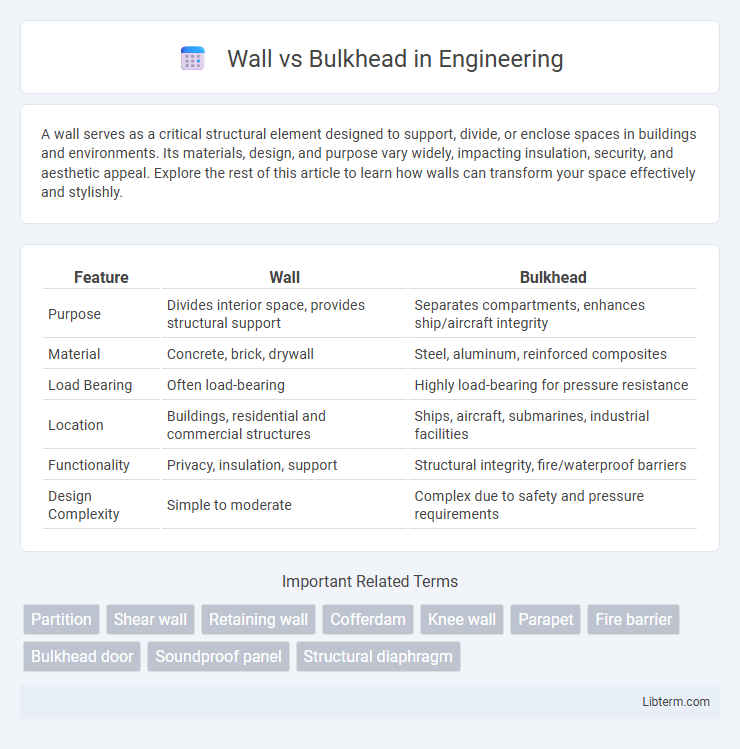A wall serves as a critical structural element designed to support, divide, or enclose spaces in buildings and environments. Its materials, design, and purpose vary widely, impacting insulation, security, and aesthetic appeal. Explore the rest of this article to learn how walls can transform your space effectively and stylishly.
Table of Comparison
| Feature | Wall | Bulkhead |
|---|---|---|
| Purpose | Divides interior space, provides structural support | Separates compartments, enhances ship/aircraft integrity |
| Material | Concrete, brick, drywall | Steel, aluminum, reinforced composites |
| Load Bearing | Often load-bearing | Highly load-bearing for pressure resistance |
| Location | Buildings, residential and commercial structures | Ships, aircraft, submarines, industrial facilities |
| Functionality | Privacy, insulation, support | Structural integrity, fire/waterproof barriers |
| Design Complexity | Simple to moderate | Complex due to safety and pressure requirements |
Introduction to Walls and Bulkheads
Walls are vertical structures that define and enclose spaces within or around a building, providing support, privacy, and protection from environmental elements. Bulkheads are specialized partitions often located in ceilings or upper wall sections, designed to conceal mechanical, electrical, or plumbing systems while maintaining accessibility for maintenance. Both walls and bulkheads play essential roles in architectural design, balancing structural integrity and functional utility.
Defining Walls: Structure and Function
Walls serve as vertical structures that define indoor spaces, providing support and division within buildings while contributing to overall stability. Constructed from materials such as wood, concrete, or steel, walls can be load-bearing, transferring structural loads to the foundation, or non-load-bearing, mainly used for partitioning. These elements play a crucial role in insulation, soundproofing, and fire resistance, enhancing both functionality and safety in architectural design.
Understanding Bulkheads: Purpose and Applications
Bulkheads serve as structural partitions primarily designed to enhance the integrity and safety of ships, aircraft, and buildings by dividing spaces to prevent the spread of fire, water, or pressure. Unlike traditional walls, bulkheads are often reinforced and engineered to withstand high impact or extreme conditions, making them essential in marine and aerospace environments. Their applications extend from creating watertight compartments in ships to providing fire-resistant barriers in commercial buildings, ensuring both safety and structural stability.
Key Differences Between Walls and Bulkheads
Walls provide full-height separation between spaces, extending from floor to ceiling, while bulkheads are partial-height structures often used to conceal mechanical systems or create architectural features. Walls typically contribute to privacy, sound insulation, and structural integrity, whereas bulkheads primarily serve aesthetic and functional purposes without bearing significant loads. Construction materials for walls vary widely, including drywall, wood, and masonry, whereas bulkheads often consist of lightweight framing and drywall to enclose ducts or pipes.
Structural Roles: Wall vs. Bulkhead
Walls primarily provide vertical support and define interior spaces by bearing loads from floors and roofs, ensuring overall building stability. Bulkheads serve as partition elements within structures, often enclosing mechanical or electrical components, and contribute to load distribution by reinforcing specific sections. The distinction lies in walls being major structural elements for load-bearing, while bulkheads function as secondary supports or protective barriers.
Common Materials Used for Walls and Bulkheads
Walls are commonly constructed from materials such as drywall, concrete, brick, and wood, offering structural support and aesthetic appeal within buildings. Bulkheads, frequently used in shipbuilding and architectural detailing, are typically made from steel, aluminum, fiberglass, or reinforced concrete to provide strength and durability against external pressures. Both walls and bulkheads utilize insulation materials like foam or fiberglass to enhance thermal and acoustic performance.
Installation Techniques: Wall vs. Bulkhead
Installing a wall typically involves framing with studs, applying drywall or other paneling, and finishing with paint or wallpaper, requiring precise measurements and alignment for structural stability. Bulkhead installation demands careful assessment of ceiling height and existing utilities, as it involves constructing a lowered section often made from drywall or plasterboard to conceal pipes or ducts. Both techniques require different structural considerations: wall installation emphasizes load-bearing support, while bulkhead focuses on integrating seamlessly with ceiling designs without compromising existing infrastructure.
Cost Comparison: Wall vs. Bulkhead
Walls generally incur higher costs than bulkheads due to greater material use and labor-intensive construction processes. Bulkheads, often built to accommodate mechanical systems or create partial barriers, tend to be more cost-effective because of their smaller scale and simpler design. When budgeting for interior projects, choosing bulkheads can significantly reduce expenses compared to installing full-height walls.
Maintenance and Durability Considerations
Walls constructed with traditional materials such as drywall and wood framing require routine maintenance including painting, patching, and potential mold prevention to ensure long-term durability. Bulkheads, often made from metal or reinforced materials to accommodate mechanical systems, demand regular inspections to detect corrosion, water damage, and structural integrity issues due to their exposure to varying environmental conditions. Both structures benefit from moisture control and timely repairs, but bulkheads typically require more specialized maintenance because of their functional role in housing utilities and their susceptibility to wear from operational stresses.
Choosing Between Wall and Bulkhead: Which is Best?
Choosing between a wall and a bulkhead depends on your space requirements and structural needs. Walls provide full separation and privacy, ideal for creating distinct rooms or soundproofing, while bulkheads primarily conceal HVAC, plumbing, or wiring, preserving ceiling height and open space. Consider the function, aesthetic preference, and construction constraints to determine the best option for your project.
Wall Infographic

 libterm.com
libterm.com